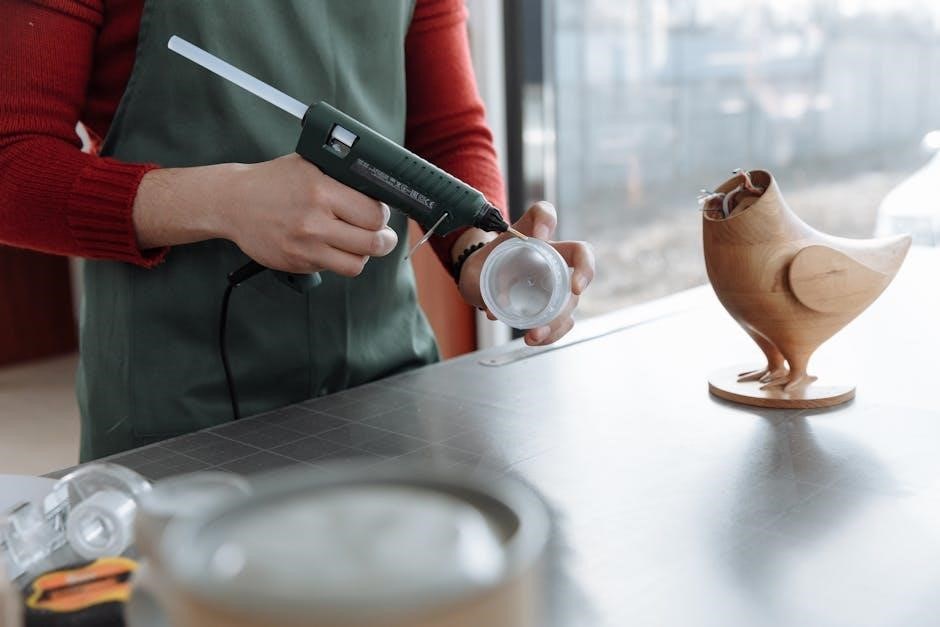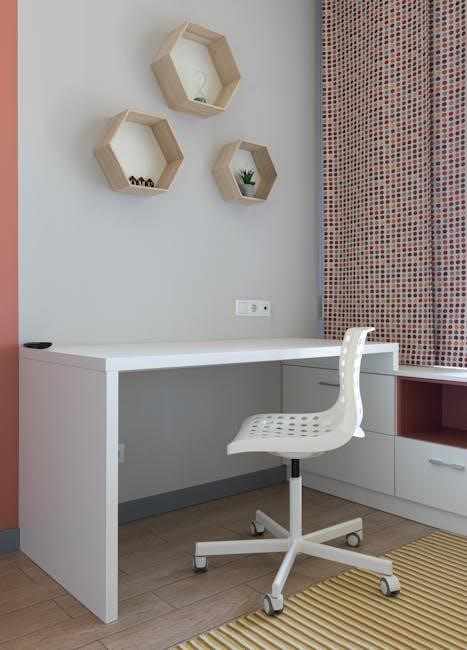l-shaped desk assembly instructions pdf
An L-shaped desk offers a space-efficient solution for home offices or workplaces, providing ample surface area and versatility. Proper assembly ensures stability and safety, making it essential to follow detailed instructions carefully. This guide will walk you through the process, from preparation to final adjustments, helping you build your desk with confidence.
1.1 Importance of Following Assembly Instructions
Following the assembly instructions for your L-shaped desk is crucial to ensure a safe and successful installation. Proper assembly prevents damage to the desk and avoids potential safety hazards. Misaligned parts or incorrect screw placement can lead to instability, risking the desk’s structural integrity. Additionally, failing to follow instructions may void the warranty. Always count and organize parts before starting, and use the recommended tools to avoid stripping screws. Taking the time to carefully read and adhere to the manual ensures a sturdy, functional, and long-lasting workspace.
1.2 Overview of the Assembly Process
The assembly of an L-shaped desk involves a series of organized steps to ensure a stable and functional workspace. Begin by unpacking and verifying all components, then proceed to attach legs and feet for stability. Next, assemble the frame and support beam to provide structural integrity. Install the desktop and shelves, ensuring proper alignment and secure fastening. Finally, attach the cable tray to manage cords neatly. Each step requires attention to detail and adherence to instructions to achieve a sturdy and aesthetically pleasing desk.

Pre-Assembly Checklist
Unpack and count all components, ensuring no parts are missing or damaged. Prepare tools like Allen keys and screwdrivers. Clear a large, flat workspace and gather safety gear.
2.1 Unpacking and Inspecting the Components
Begin by carefully unpacking all components from the box. Lay them out on a flat, stable surface, preferably on a soft cloth to prevent scratching. Inspect each part for any signs of damage, such as dents, scratches, or broken edges. Check for all hardware, including screws, bolts, and washers, ensuring nothing is missing. If any parts are damaged or missing, contact customer support immediately to avoid delays. This step ensures a smooth assembly process and helps identify issues early on.
2.2 Tools and Materials Required
Gather all necessary tools and materials before starting assembly. Typically, you’ll need an Allen wrench, screwdrivers (Phillips and flathead), bolts, screws, and washers. Ensure you have a measuring tape for accurate alignment and a soft cloth to prevent surface scratches. Safety gloves are recommended to protect your hands. Some desks may require additional tools like a wrench for specific bolts. Having all items ready ensures a smooth and efficient assembly process. Double-check the list provided in the instruction manual to confirm you have everything needed.
2.3 Safety Precautions
Before starting assembly, read the manual thoroughly and understand all components. Wear protective gloves and safety glasses to prevent injuries. Ensure the workspace is clear and well-lit to avoid accidents. Keep children and pets away during assembly. Avoid overloading shelves or drawers, as this can compromise stability. Never exceed the weight limits specified in the instructions. Use tools correctly and follow step-by-step guidance to prevent damage or personal harm. Double-check all connections before placing heavy objects on the desk to ensure safety and durability.

Step-by-Step Assembly Instructions
Welcome to the detailed guide for assembling your L-shaped desk. Follow these organized steps to ensure a smooth and successful assembly process. Stay organized, and use the correct tools for each task to achieve professional results.
3.1 Attaching the Legs and Feet
Begin by unpacking and identifying the legs, feet, and associated hardware. Attach each foot to the desk legs using the provided screws and an Allen key. Ensure the feet are securely tightened to maintain stability. Place the desk on a carpet or soft surface to prevent scratching during assembly. Align the legs properly with the desktop frame, ensuring even distribution of weight. Tighten all connections firmly but avoid overtightening, which may damage the hardware. Double-check the alignment and stability before proceeding to the next step. This ensures a sturdy foundation for your L-shaped desk.
3.2 Assembling the Frame and Support Beam
Place the support beam on a flat surface and align it with the frame’s pre-drilled holes. Secure the beam using the provided long screws and tighten with an Allen key. Ensure the beam is evenly spaced and aligned to maintain structural integrity. Attach the frame to the legs, making sure all connections are tight. Once the frame is stable, carefully flip it upright. Install any additional support brackets or crossbars as indicated in the instructions. This step is crucial for ensuring the desk’s stability and proper weight distribution.

3.3 Installing the Desktop and Shelves
Place the desktop on a soft, flat surface to avoid scratching. Align the pre-drilled holes on the desktop with the frame’s corresponding holes. Use the provided screws and Allen key to secure the desktop tightly. Ensure the desktop is flush with the frame for even support. If shelves are included, attach them to the desktop using the specified brackets or clips. Double-check the alignment and tighten all screws firmly. For stability, have a second person assist in holding the desktop steady during installation. Ensure all surfaces are level before finalizing the setup.
3.4 Securing the Cable Tray and Accessories
Attach the cable tray to the underside of the desktop using the provided screws and washers. Ensure the tray is aligned with the pre-drilled holes and securely fastened. For stability, place spring washers between the screws and the frame. Align the hooks on the cable tray with the corresponding holes on the desk frame and press down firmly until they click into place. Tighten all connections to prevent movement. Use cable clips to organize wires and keep them tidy. Double-check that the cable tray is evenly balanced and does not exceed the weight limit specified in the instructions.

Troubleshooting Common Issues
Identify missing or damaged parts early and address alignment or stability problems promptly. Refer to the manual for solutions or contact customer support for assistance.
4.1 Identifying Missing or Damaged Parts
Before assembly, carefully inspect all components for damage or defects. Count and verify each part against the provided parts list to ensure nothing is missing. If any item is damaged or absent, contact customer service promptly for replacement. This step is crucial to avoid delays and ensure a smooth assembly process. Always refer to the manual for accurate identification and troubleshooting guidance.
4.2 Resolving Alignment and Stability Problems
If alignment issues arise during assembly, ensure all screws are securely tightened and the frame is properly aligned. For stability problems, check that all legs are evenly placed and the desk is on a level surface. If wobbling occurs, adjust the feet or use shims to balance the desk. Verify that all support beams and crossbars are correctly installed and tightened. If issues persist, refer to the troubleshooting section in the manual or contact customer support for assistance. Proper alignment ensures safety and optimal functionality.
Final Adjustments and Maintenance
Ensure all connections are secure and tighten any loose screws. Clean the surface with a damp cloth and apply a protective finish. Regularly inspect for stability and perform adjustments as needed to maintain optimal condition and longevity.
5.1 Tightening All Connections
Once the desk is fully assembled, inspect all connections to ensure they are secure. Use an Allen wrench or screwdriver to tighten any loose screws or bolts. Pay special attention to the legs, frame, and support beams, as these are critical for stability. Double-check the desktop and shelf attachments to prevent wobbling. Avoid over-tightening, as this could damage the material. Finally, review the entire structure to ensure all parts are properly aligned and secured. This step is essential for both safety and the longevity of your L-shaped desk.
5.2 Cleaning and Protecting the Surface
After assembly, clean the desk surface with a soft, damp cloth to remove dust or debris. Avoid using harsh chemicals or abrasive cleaners, as they may damage the finish. For glass or wooden surfaces, apply a mild furniture polish or sealant to protect against spills and scratches. Regular cleaning prevents dust buildup and maintains the desk’s appearance. Avoid placing hot objects directly on the surface and use coasters or pads for electronics. Proper care ensures the longevity and aesthetics of your L-shaped desk.
Warranty and Customer Support
Your L-shaped desk is backed by a manufacturer’s warranty covering defects in materials and workmanship. For inquiries or claims, contact customer support via email or phone for assistance with repairs or replacements.
6.1 Understanding the Warranty Terms
Your L-shaped desk is protected by a limited warranty covering manufacturing defects in materials and workmanship. The warranty period typically ranges from 1 to 5 years, depending on the manufacturer; Coverage includes repair or replacement of defective parts but excludes damage caused by misuse, normal wear, or unauthorized modifications. To file a claim, contact customer support with proof of purchase and detailed photos of the issue. Ensure compliance with warranty terms to maintain coverage and resolve issues promptly. Always review the warranty document for specific conditions and exclusions.
6.2 Contacting Customer Service
For assistance with your L-shaped desk, contact customer service via email, phone, or live chat through the official website. Provide your order number, product details, and a description of the issue. Attach photos of damaged or defective parts if applicable. Responses are typically within 24-48 hours. Ensure you have your warranty document and purchase receipt ready for faster resolution. Visit the manufacturer’s website for contact information and support resources. Reaching out promptly helps resolve issues efficiently and ensures your desk functions as intended.
With careful planning and adherence to instructions, your L-shaped desk assembly will be successful. Enjoy your newly assembled workspace, designed for efficiency and productivity, and maintain it well for lasting durability.
7.1 Final Tips for a Successful Assembly
Ensure all bolts and screws are tightly secured for stability. Clean the desktop with a soft cloth to remove dust or debris. Regularly inspect and tighten connections to maintain durability. Place items mindfully to avoid overloading shelves or surfaces. Keep cables organized using the provided tray to prevent tangling. Finally, enjoy your newly assembled L-shaped desk, knowing it’s built to enhance your productivity and comfort. Proper care and maintenance will extend its lifespan and performance.

